Identifying Corrosion After Storms
When hurricanes strike, they have the potential to cause extensive damage both in immediate destruction and in long-term corrosion effects. Our experts can help you understand the effects and find appropriate mitigation strategies for dealing with the damage and ingress of water in unexpected places that hurricanes can bring. A thorough hurricane damage assessment can help you save money down the road by identifying and fixing potential corrosion areas before they become problematic.
Corrosion from Hurricanes
In some cases, the corrosion damage doesn’t show until months or years later. The condo collapse shown below was instigated by corrosion damage from a previous hurrricane:

The storm surge and powerful winds from hurricanes can result in exposure to saltwater in places where it was never expected. Over time, the salt can lead to accelerated corrosion of many materials, leaving them susceptible to failure by pitting corrosion, stress corrosion cracking, and corrosion fatigue.

Types of Hurricane Damage Assessment
There are actually several types of hurricane damage assessment, of which we focus only on one:
- FEMA Damage Assessment – this is a broad, region-wide assessment produced by FEMA each year (Not what we do.)
- Damage Assessment Survey – this is the method that surveyors use in neighborhoods to determine the extent of damage to houses and facilities (Not what we do.)
- Corrosion and Structural Damage Assessment – focused on one facility, this is an evaluation of current damage and potential future corrosion issues (This is what we offer!)
Our team of experts can help with a wide range of assessments that may be necessary after a hurricane. We use tools such as field metallography, hardness testing, chemical analysis, and corrosion testing to help assess the damage and provide a intelligent path forward.
Ready to get started with a hurricane damage assessment? We look forward to helping you recover: